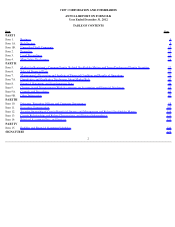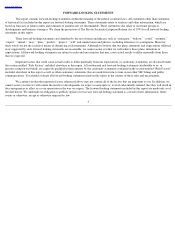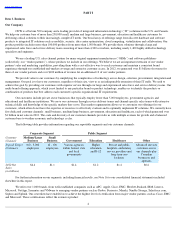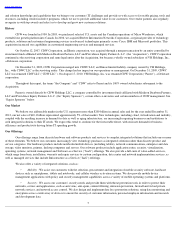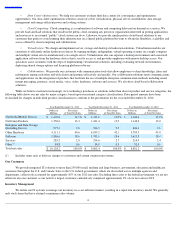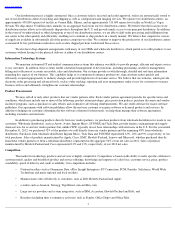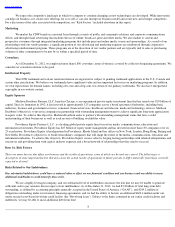CDW 2012 Annual Report Download - page 13
Download and view the complete annual report
Please find page 13 of the 2012 CDW annual report below. You can navigate through the pages in the report by either clicking on the pages listed below, or by using the keyword search tool below to find specific information within the annual report.
Table of Contents
Risks Related to Our Business
General economic conditions could negatively affect technology spending by our customers and put downward pressure on prices, which
may have an adverse impact on our business, results of operations or cash flows.
Weak economic conditions generally, sustained uncertainty about global economic conditions, skepticism about the resolution of U.S.
fiscal cliff negotiations and the implementation of resulting agreements, concerns about future scheduled budgetary cuts and that the U.S.
government may reach its debt ceiling in early 2013, or a prolonged or further tightening of credit markets could cause our customers and
potential customers to postpone or reduce spending on technology products or services or put downward pressure on prices, which could have an
adverse effect on our business, results of operations or cash flows. For example, during the economic downturn at the end of 2008 and in 2009,
due to a number of factors, including declines in the availability of credit, weakening consumer and business confidence and increased
unemployment, we experienced significantly reduced revenue and gross margins when our customers and potential customers reduced their
spending on technology and put downward pressure on prices.
Our financial performance could be adversely affected by decreases in spending on technology products and services by our Public segment
customers.
Our sales to our Public segment customers are impacted by government spending policies, budget priorities and revenue levels.
Although our sales to the federal government are diversified across multiple agencies and departments, they collectively accounted for
approximately 10% of 2012 net sales. An adverse change in government spending policies (including budget cuts at the federal level resulting
from sequestration), budget priorities or revenue levels could cause our Public segment customers to reduce their purchases or to terminate or not
renew their contracts with us, which could adversely affect our business, results of operations or cash flows.
Our business depends on our vendor partner relationships and the availability of their products.
We purchase products for resale from vendor partners, which include OEMs and software publishers, and wholesale distributors. For
the year ended December 31, 2012, we purchased approximately 52% of the products we sold directly from vendor partners and the remaining
amount from wholesale distributors. We are authorized by vendor partners to sell all or some of their products via direct marketing activities.
Our authorization with each vendor partner is subject to specific terms and conditions regarding such things as sales channel restrictions, product
return privileges, price protection policies, purchase discounts and vendor partner programs and funding, including purchase rebates, sales
volume rebates, purchasing incentives and cooperative advertising reimbursements. However, we do not have any long-term contracts with our
vendor partners and many of these arrangements are terminable upon notice by either party. A reduction in vendor partner programs or funding
or our failure to timely react to changes in vendor partner programs or funding could have an adverse effect on our business, results of operations
or cash flows. In addition, a reduction in the amount of credit granted to us by our vendor partners could increase our need for, and the cost of,
working capital and could have an adverse effect on our business, results of operations or cash flows, particularly given our substantial
indebtedness.
From time to time, vendor partners may terminate or limit our right to sell some or all of their products or change the terms and
conditions or reduce or discontinue the incentives that they offer us. For example, there is no assurance that, as our vendor partners continue to
sell directly to end users and through resellers, they will not limit or curtail the availability of their products to resellers like us. Any such
termination or limitation or the implementation of such changes could have a negative impact on our business, results of operations or cash
flows.
Although we purchase from a diverse vendor base, in 2012, products we purchased from distributors Ingram Micro, Tech Data and
SYNNEX represented 12%, 10% and 9%, respectively, of our total purchases. In addition, sales of Apple, Cisco, EMC, Hewlett-Packard,
Lenovo and Microsoft products comprise a substantial portion of our sales, representing approximately 56% of net sales in 2012. Sales of
products manufactured by Hewlett-Packard and Cisco represented approximately 21% and 13%, respectively, of our 2012 net sales. The loss of,
or change in business relationship with, any of these or any other key vendor partners, the diminished availability of their products, or backlogs
for their products leading to manufacturer allocation, could reduce the supply and increase the cost of products we sell and negatively impact our
competitive position.
Additionally, the relocation of key distributors utilized in our purchasing model could increase our need for, and the cost of, working
capital and have an adverse effect on our business, results of operations or cash flows. Further, the sale, spin-off or combination of any of our
vendor partners and/or certain of their business units, including any such sale to or combination with a vendor with whom we do not currently
have a commercial relationship or whose products we do not sell, could have an adverse impact on our business, results of operations or cash
flows.
10




